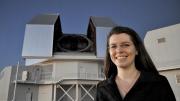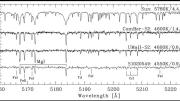Some explore the origins of the universe by seeking to observe the most distant galaxies (see “Conjuring the Cosmos,” page 34). Anna Frebel instead practices “stellar archaeology.” The former Clay Fellow at the Harvard-Smithsonian Center for Astrophysics, now assistant professor of physics at MIT, compares the unusual chemistry of ancient stars in the Milky Way’s halo (the galactic outskirts, a hundred thousand to a few hundred thousand light years away) with that of stars in dwarf galaxies (“the wimpiest, faintest galaxies,” she fondly calls them) that still orbit the Milky Way. Her painstaking observations reveal that both populations are similar: these “low-metallicity” stars (with dramatically less iron, for instance, than such comparative newborns as the Sun) date from distant cosmological history, 13 billion years ago, close to the era when the only elements were hydrogen, helium, and a trace of lithium.
If that hypothesis is correct, astronomers can focus attention on these relatively nearby targets to explore the events that followed the Big Bang, interpreting the processes that formed early stars and galaxies from their surviving remnants (hence, archaeology), long since cannibalized by younger structures like the Milky Way. In 2007, Frebel found one of only two known old stars with measurable amounts of uranium—a massively heavy element thought to have formed in the collapse of an early-generation star and its explosion as a supernova, an event that could have enriched subsequent star-forming gas clouds. Radioactive elements such as uranium and thorium, given their known rate of decay, offer uniquely valuable tools to date a star’s contents. Much more data must be collected, but the research to date, she writes, “raises the hope that we have finally identified a Rosetta Stone of cosmic chemical evolution….”
In “Four Starry Nights,” an account of her observations published in Scientific American last December, Frebel details the difficulty of collecting the information she needs, even when using the Carnegie Observatories’ powerful Magellan telescopes in Chile: “Ideally, I want to observe each dwarf galaxy star on my target list for a total of 10 hours because these stars are so faint….” But because energetic cosmic rays constantly hit Earth—and the telescope’s detector—she has to limit those observations to 55-minute segments (lest background noise overwhelm the wanted signal). The metrics for a successful night of observation, she writes, include tracking “the number of photons I have collected so far, the positions of my target stars in the night sky, and the weather forecast.”
Those constraints—and absolute limits on collecting light from any stars other than the brightest few in her target dwarf galaxies (without which, documenting their detailed chemical evolution is impossible)—explain Frebel’s enthusiasm for next-generation instruments that could get her more light, from fainter sources, more quickly. She played a significant role in framing the Giant Magellan Telescope’s (GMT) recently revised science agenda, and chaired the scientific working group that defined the telescope’s high-resolution optical spectrograph (see “Exploring Exoplanets,” page 36). Of course, even the GMT cannot overcome occasional adverse weather.
Current theory suggests that the first stars and galaxies formed when the universe was perhaps half a billion years old. “That may not be right, but it’s not wrong,” Frebel says. “We just don’t know better”—yet. Research with more powerful observing tools will also yield insights into how the universe was seeded and enriched with elements like carbon: the building-block of life. “We come to some extent right from the Big Bang,” Frebel says. “We are made from star stuff.” The GMT thus will help astronomers and astrophysicists get closer to answering questions about matters both incredibly large and atomically small.












